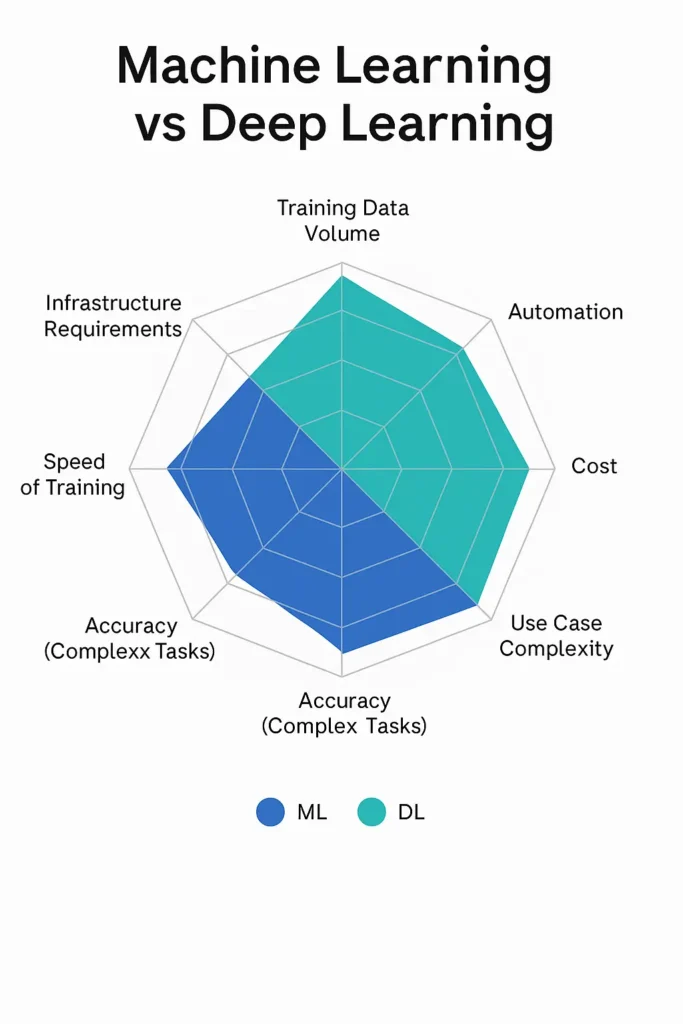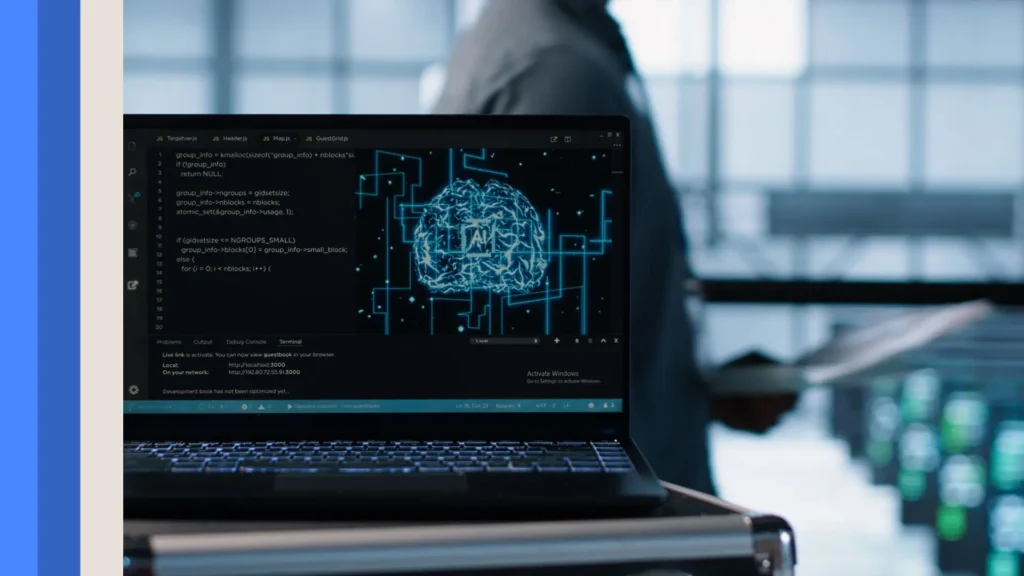Machine learning
Machine learning serves as an AI subfield that empowers machines and computers to mimic human learning patterns while allowing them to conduct self-run operations and boost their efficiency by processing larger quantities of data.
Machine learning requires human engineers to supply it with proper data that has received relevant processing before reaching the algorithm. ML performs complex problem-solving and generates valuable insights through its ability to detect patterns in data when staff members provide additional assistance. The standard operations for an optimized ML model begin with team training until performance reaches its peak.
The system will accept input from users via queries.
- Analyze the data
- Find a pattern
- Make a prediction
The system delivers the response to the user.
For each query execution, this system runs a process that is differentiated primarily based on the training methods different models use. There exist three primary learning methods that ML models utilize.
The learning procedure known as supervised learning requires machines to operate with labeled training data, which helps develop models for data responses.
The training process of ML models includes data input with trial-and-error feedback loops for autonomous learning.
Different users require different learning approaches based on their needs and expectations, particularly when an ML model operates as an intelligent automation system.
An example of machine learning:
Several on-demand recommendation systems are operationalized through machine learning and reinforcement learning as services, including Spotify and Apple Music, along with YouTube. The user’s musical preferences, such as saved songs along with playlists, followed creators, and favored videos, serve as inputs for ML systems, which connect these preferences to related artists and albums and other content with compatible musical tastes.
Deep learning
Deep learning operates under machine learning by implementing artificial neural networks to function independently for learning patterns and decision-making tasks, and forecasting accuracy.
Deep learning models gain extensive knowledge from continuous data analysis to make conclusions by processing information with data reserves to determine answers.
Neural networks exist in different forms, which include:
- A feedforward neural network (FF or FFNN) operates as an artificial system that transmits data sequentially from input nodes toward output nodes. Deep learning starts here, but it does not involve the use of cycles or loops.
- RNNs function as AI algorithms by integrating internal feedback loops, which allow them to hold onto past data points. The memory function of RNNs helps them connect past experiences to their processing of present information and future prediction capabilities.
- LSTM stands for Long/Short-term memory (LSTM), which represents a specific recurrent neural network made to preserve long-term connections between sequential information. These neural networks deliver their best performance when working on problems requiring earlier input information to understand current processes.
- CNNs function as algorithms that lead the processing of images and visual recognition tasks through computer systems. Visual prompts enter networks that evaluate their different characteristics, including patterns and textures and shapes and colors, and other elements.
- GANs represent deep learning frameworks that contain two connected neural networks to both generate artificial information and recognize authentic inputs from synthetic outputs.
Build your machine learning and deep learning skills today
- Modern AI technologies shape the way numerous people perform their work duties. Use Coursera to learn basic machine learning and deep learning concepts through these available programs.
- Six-hour training delivers essential AI terms, followed by ML project building experience, and demonstrates how businesses team up to create workplace AI strategies.
- The Machine Learning Specialization at Stanford University with DeepLearning.AI provides students with essential AI principles and functional machine learning abilities.
- During the two-month training period, you will gain knowledge to create ML models and establish best development practices, and implement neural network development and training.
- AI provides educational material about deep learning in its fundamental specialization. This intermediate-level education teaches students to construct deep neural networks and train them, along with identifying essential network parameters and running test set training procedures.
Key difference: Machine learning and deep learning
Deep learning functions as a particular classification within the wide field of machine learning (ML). Source thinkers can regard deep learning as a developed form of machine learning.
The systems support numerous distinct applications. Deep learning solutions require substantial resources, which include large datasets together with necessary infrastructure and their associated costs.

Various distinctions exist between these two methods, as shown below.
Intended use cases
When choosing between using machine learning and deep learning philosophy, the selection of data processing type serves as the determining factor. ML determines patterns within structured data through its classification and recommendation system operations. The analysis of client churn data through ML allows companies to forecast the moment when customers unsubscribe.
Unstructured data requires deep learning solutions because deep abstraction methods are necessary to extract features from the data. The technology of deep learning focuses on two main tasks, explained by image classification as well as natural language processing, because these applications demand understanding complex data interrelationships. Through deep learning technology,y organizations can evaluate social media posts to identify the emotional responses of users.
Problem-solving approach
Within traditional ML methods, humans need to perform feature engineering by choosing important features from raw data before assigning weight values. The process of feature engineering in deep learning solutions runs without significant human supervisor involvement.
A neural network design that is deeper forms the core functionality of deep learning solutions. Deep learning solutions follow human brain learning patterns, which are represented by nodes that mimic neural structures. Deep neural networks organize their nodes into three minimum layers with the addition of both input and output nodes.
Autonomic weighting operates at every node of the neural network to assign values to features. A forward data transmission route operates from the input layer through the entire network to the output layer. The system generates an error measurement through the comparison of estimated output results against real output values. The network applies the identified error for weight adjustments of its neurons.
Deep learning requires solving more operations than ML because it enables automatic weighting of illustrations and detailed architectural levels, combined with its techniques.
Training methods
Eight primary training procedures within ML include supervised learning and unsupervised learning, together with semi-supervised learning, along with reinforcement learning. The field also incorporates two additional training methods, which are transfer learning and self-supervised learning.
Deep learning algorithms require multiple complex methods for training operations.
Performance
ML, together with deep learning, has distinct applications where one approach performs superior than the other.
ML proves more suitable than deep learning for detecting new incoming spam messages while achieving superior results compared to its deep learning counterpart. Medical imaging recognition requires deep learning solutions to achieve better performance than ML solutions because deep learning can detect visual abnormalities that humans cannot see.
Infrastructure requirements
A deep learning model generally needs extensive high-performance clusters and additional significant infrastructure for successful operation.
Deep learning solutions need expensive infrastructure systems that surpass the total cost of ML implementations. A deep learning system implementation with on-site infrastructure becomes a financially impractical decision.

What limitations of machine learning led to the evolution of deep learning?
The process of feature engineering demands major human input for traditional Machine Learning systems to generate outputs.
- An ML model that classifies images of cats and dogs requires manual initialization to recognize eye shape and tail shape, and ear shape, as well as nose outlines during its training period.
- The development of deep learning eliminates the dependence on human labor to assign labels during each step because it aims to minimize human involvement.
- Deep learning techniques emerged over many decades, yet scientists Yann LeCun, Yoshua Bengio, and Geoffrey Hinton dedicated their efforts to further explore this field throughout the early 2000s.
- During the time when scientists made progress in deep learning, they faced challenges due to the minimal availability of extensive datasets and high training costs to run models. Research conditions leading to the commercialization of deep learning have improved during the last twenty years.





